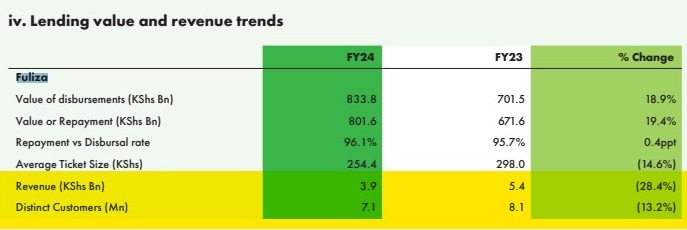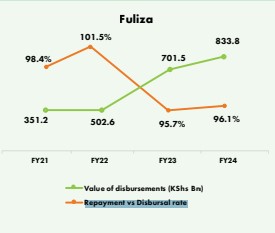In the financial year ending March 2024, Safaricom’s M-PESA revenue grew 19.5% year-over-year (YoY) to KES 140,006.7 million. This means M-Pesa remains Safaricom’s PLC biggest revenue earner contributing 42.2% of total revenue earned. The total value of M-Pesa transactions increased to KES 40.24 trillion, while the number of transactions surged by 33.9% YoY to KES 28.33 billion.
This is continued evidence that M-Pesa remains a key player in Kenya’s finance sector rivalling top banks such as KCB Bank Kenya and Equity Bank. It comes as no surprise that calls to split M-Pesa from the mother company have resurfaced.
As per company data, Safaricom’s M-Pesa has 34.64 million customers. A significant 90.9% (31.51 million) of M-Pesa customers actively used the platform at least once a month throughout the year.
Based on Communication Authority of Kenya report for the period ending December 2023, Kenya has a total of 38,002,803 mobile money subscriptions. This means about 91.2 % of the Kenyan mobile money sector is held by M-Pesa.
For its Ethiopia market, M-PESA has grown to 4.5 million registered customers since launch in 2023.
Reduced M-Pesa Deposits
However, despite the good overall numbers, there was a slight decline in customer deposits for the last half of FY23/24. Deposits into M-Pesa between September 2023 and March 2024 reached KES 263.3 billion. This was a KES 10.6 billon drop. In the preceding six months, M-Pesa customers had deposited KES 273.9 billion in their wallets.
READ: Mobile Money: Kenyan Regulations and Fees Cause Decline in Transaction Values
Safaricom has not given explicit reasons that may have led to this decline. It is worth noting that this decline came after the Finance Bill 2023 was enacted into law. The bill led to an increase in M-Pesa charges and customers may have resorted to cash and other platforms such as banks a little bit more.
Still, Lipa Na M-PESA active merchant numbers grew and now stand at 633,009 while Pochi La Biashara tills grew to 632,681. The value of Lipa na M-Pesa payments grew to KES 2,075.6 billion.
Decline in Fuliza Customers
In partnership with two commercial banks in Kenya, NCBA and KCB Bank, Safaricom runs a credit overdraft facility dubbed “Fuliza”. This product is meant to cover short-term cashflow shortfalls subject to an applicable pre-determined limit. The two banks act as underwriters.
Fuliza is an opt in service and customers can opt out anytime they wish. For the financial year, ended March 2024, 1 million customers opted to unsubscribe from the service. While Safaricom has dropped Fuliza charges by up to 50%, customers may still be finding the facility charges expensive. Based on data from Safaricom, Fuliza customers stand at 7.1 million down from 8.1 million at the end of the previous financial year.
Read: How to Opt Out of Fuliza
The decline in Fuliza customer base had its impact, with the average amount borrowed per person dropping 14.6% to KES 254.4. This resulted in a 28.4% decrease in total revenue, reaching KES 3.9 billion. This is the first time there has been such a drop in revenue.

Fuliza total disbarments has constantly been rising since 2019. The Repayment vs Disbursal rate also had a slight growth after declining in previous years.

In terms of disbursements to customers, for the financial year ending March 2020, KES 245 billion was disbursed. The next financial year, FY21, saw KES 351 billion disbursed. FY22 had KES 502.6 billion disbursement via Fuliza. With FY23 registering KES 701.5 billion and FY24 KES 833.8 billion, it means KES KES 2,633,900,000,000 (KES 2.634 trillion) has been disbursed to Fuliza customers since launch.



























